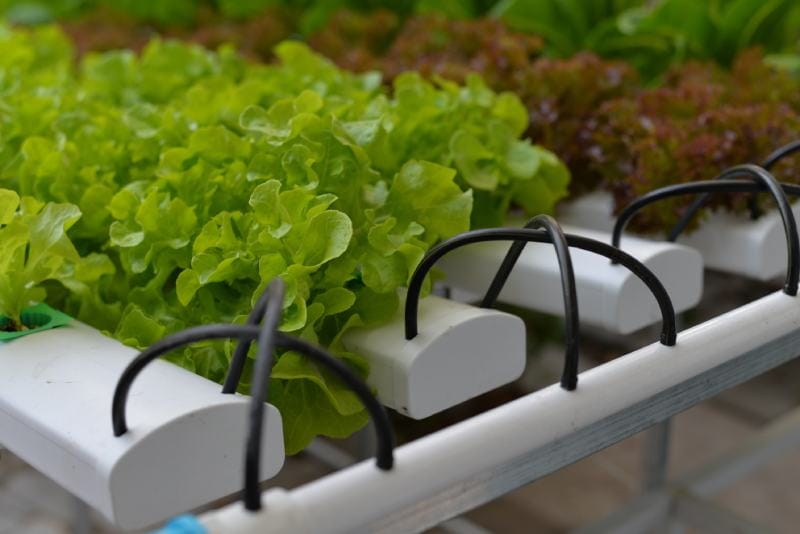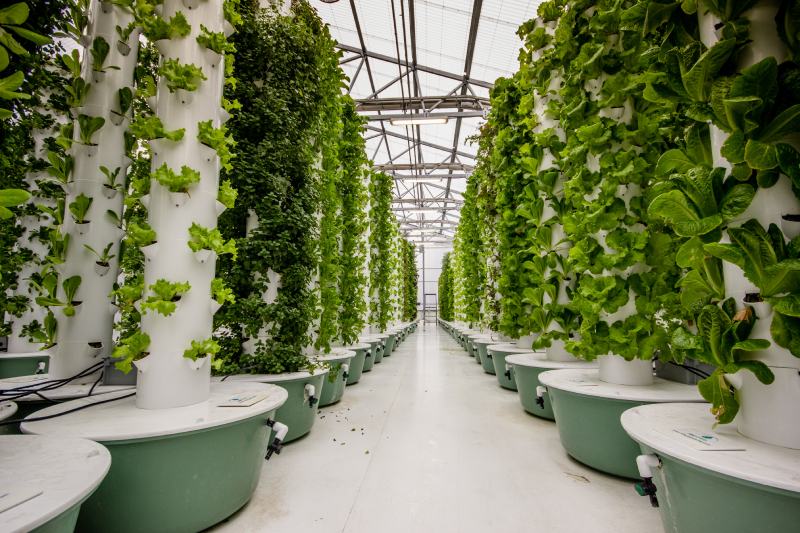6 Types of Hydroponic Systems Explained (With Pictures)
-
Pete Ortiz
- Last updated:

With the market having an anticipated annual growth rate of over 20% through 2028,1 hydroponics is quickly becoming the preferred growing method for professional and amateur gardeners.
Hydroponic systems give plants everything they need—water, light, air, and nutrients—and nothing they don’t, making them more efficient than the traditional garden. When plants need less space and water but deliver healthier yields, taking soil out of the equation is a no-brainer for an at-home setup.
Hydroponics can take several forms, so finding an arrangement that works around your budget and needs isn’t challenging. We’ll help you pick the best setup for your indoor garden by explaining the six primary types of hydroponic systems.
The 6 Types of Hydroponic Systems
1. Wick System
A wick system is one of the most straightforward hydroponic systems to put together and an excellent technique for beginners. The passive setup doesn’t require any pumps to move the nutrient-rich solution or oxygen, so you won’t have to worry about an electrical supply.
The plant’s roots stay exposed to oxygen in a growing medium. A series of wicks feed them by connecting them to a reservoir of nutrient-rich solution sitting underneath the plants. Wicks are made from absorbent materials like nylon rope or felt strips. Through capillary action, the wicks self-regulate the flow of the solution to the roots, providing a consistent supply according to the plant’s needs.
Like many other hydroponic systems, wick systems use absorbent and aerating materials, like vermiculite, perlite, coconut coir, or expanded clay, as growing mediums. Because they only receive moisture and nutrients from slow-feeding wicks, these systems are impractical for plants that demand lots of water.
- Inexpensive and easy to set up
- No electricity required
- Works well for herbs and other small, leafy plants
- Wicks are impractical for large plants or vertical gardens
- Nutrients and water may not absorb evenly
- Wicks may need monitoring for rot, mold, and mildew buildup
2. Deep Water Culture

A deep-water culture (DWC) is another straightforward hydroponic system. In a DWC, plant roots sit directly in a bucket of the solution, giving them a constant water and nutrient supply.
A net pot with a growing medium holds the plant in place. An airstone or diffuser at the bottom of the bucket creates air bubbles through the solution to deliver oxygen to the roots. A popular way of setting the net pots in the water is to use a styrofoam raft. The raft holds the containers in holes while it floats, dipping the plant bottoms in the water and keeping the top half above the solution.
A DWC is a simple setup with the most basic electrical demands. It supplies an ongoing wealth of nutrients and oxygen to the plant’s roots, allowing it to develop quickly. Monitoring the diffuser is crucial, as any failure could cause the roots to drown from lack of air.
- Easy to assemble and inexpensive
- Abundance of water, nutrients, and oxygen inspires fast growth
- Stagnant water supply may be susceptible to algae, bacteria, and other contaminants
- Not ideal for long-lived plants
- Roots can drown if the power dies
- Requires frequent monitoring
3. Ebb and Flow
Though slightly more complex than a DWC, the ebb and flow system is nevertheless popular among home gardeners because of its simplicity and customizability. An ebb and flow, or flood and drain, uses a tray sitting above a reservoir of nutrient solution. You can fill the tray in one of two ways:
- Fill it directly with a growing medium and add plants to it
- Place plants in individual perforated pots (about twice as deep as the tray) filled with growing medium and set them in the tray
In either case, the system uses a pump in the reservoir to feed water to the tray, slowly filling it to a set point. After filling the tray, the solution drains via gravity through a drain tube or a reversible pump, putting it back into the system for reuse. Some growers also include an aerator in the reservoir to oxygenate and circulate the solution.
The ebb and flow system works on a timer, giving you complete control over the irrigation schedule. The significant advantage over a DWC is the dry period, giving the roots time to breathe and dry out. You can grow a more diverse variety of plants in this system and dial in the wet and dry times to optimize the conditions for whatever you are growing.
- Effective for a broad array of plants
- Provides excellent aeration
- Lowers likelihood of root rot and contamination
- Easy to customize feeding timing
- Requires careful calculation to optimize flooding cycles
- Pump may clog and cause roots to flood or dry out
- Requires frequent monitoring
4. Nutrient Film Technique (NFT)

The nutrient film technique is a scalable hydroponics system ideal for smaller plants like herbs and leafy greens. Because it uses channels, it can only handle plants with smaller root systems.
In an NFT, plants sit in containers with the roots hanging in a channel, which rests at a gentle angle. A pump connected to a reservoir sends a nutrient-rich solution to one end of the channel. Gravity causes the solution to flow down it, feeding every plant sitting along its length. At the end of the run, the solution drains back into the reservoir for recirculation.
An NFT makes excellent use of space. Several arrangements allow gardeners to stack channels, letting them grow numerous plants in small areas along walls and out-of-the-way places. Many NFTs run continuously, exposing plant roots to a constant blend of solution and oxygen. Although you’ll still need to consider the drainage angle and flow rate to keep the roots healthy, you won’t have to worry about setting up a timer.
- Typically does not require growing medium
- Relatively simple to set up
- Roots are easy to inspect and treat
- Does not require timers
- Easy to scale for large amounts of plants
- Does not work with plants with large root systems
- Requires frequent monitoring
- Overcrowded roots could tangle together or block the channel
- Pump clogs and breakdowns could dry out roots
5. Drip System
A drip system is similar to drip irrigation in the garden. The plants sit in containers filled with a growing medium while a pump sends nutrient solution from a reservoir to a series of drip nozzles positioned over them.
Drip systems are scalable, customizable, and all-around versatile systems. You can use them for plants of any size, as they sit in individual containers, and rearranging them is easy if you add more plants to the system. Simply connect new hoses and adjust the drip emitter to the desired flow rate.
Gardeners have several layers of control in feeding individual plants. Different growing mediums will hold and release moisture to varying degrees, and you can choose the kind most appropriate for your plant’s needs. Meanwhile, you can set up your pumps on a timer and adjust the drip emitters to deliver a precise amount of solution.
- Works for plants of all sizes
- Provides consistent aeration and moisture
- Easy to scale and adjust for different crops
- Reduces risk of root rot and disease
- Offers several levels of control
- Tubing can clog and leak easily
- Pump breakdowns will dry out roots
- Nutrient levels and pH require frequent monitoring
6. Aeroponics

Aeroponic setups are some of the most complex systems to put together. With their roots exposed, the plants sit in containers suspended in the air over a reservoir. A water pump connects to a mister (or several misters) that sprays the roots with fine particles. You can set the mister to work on a timer or use it continuously.
Although it’s pricier and more complicated to set up than many other systems, aeroponics ensures plant roots stay aerated and well-saturated. The growing medium is less of a concern due to the direct exposure of the roots to the nutrient solution. Large plants can be challenging to grow in this design, as misters will have a more difficult time with deep moisture distribution in a thicker root system.
- Does not require a growing medium
- Provides optimal oxygen and moisture
- Uses minimal nutrient solution
- The solution does not require aeration
- Limits the spread of disease
- Uses more energy
- Relatively expensive
- Not ideal for large plants
- Requires a spacious aeroponics chamber
Conclusion
Hydroponics can sound like a daunting prospect for a beginning gardener, but many setups are surprisingly simple. It often only takes a few containers, a simple pump, and a couple of lines to get started, and the yields will surely be worth the minor amount of extra effort. With an understanding of the various hydroponic systems, you’ll have no problem getting spectacular results with your favorite plants.
Featured Image Credit: Poring Studio, Shutterstock
Contents


